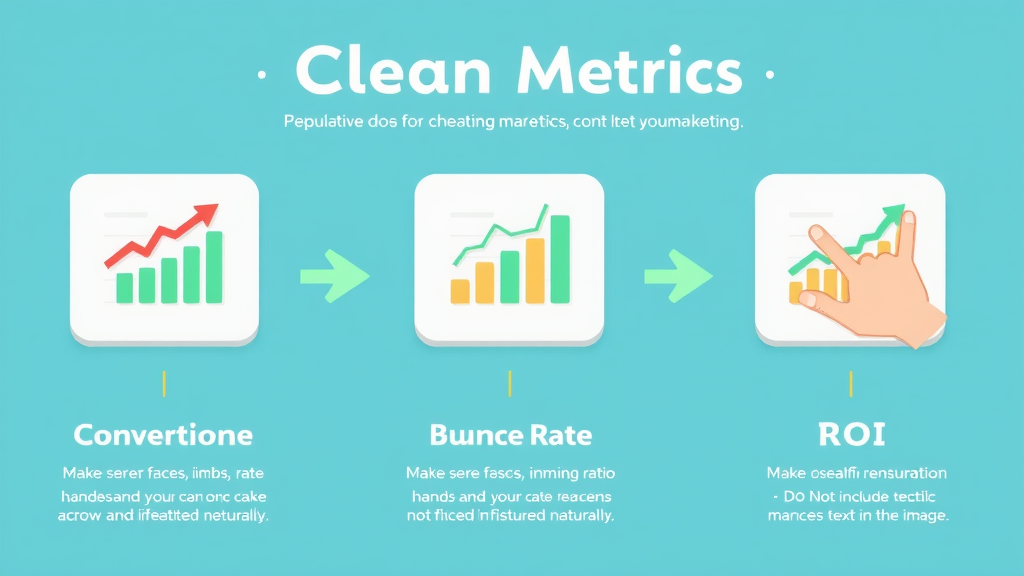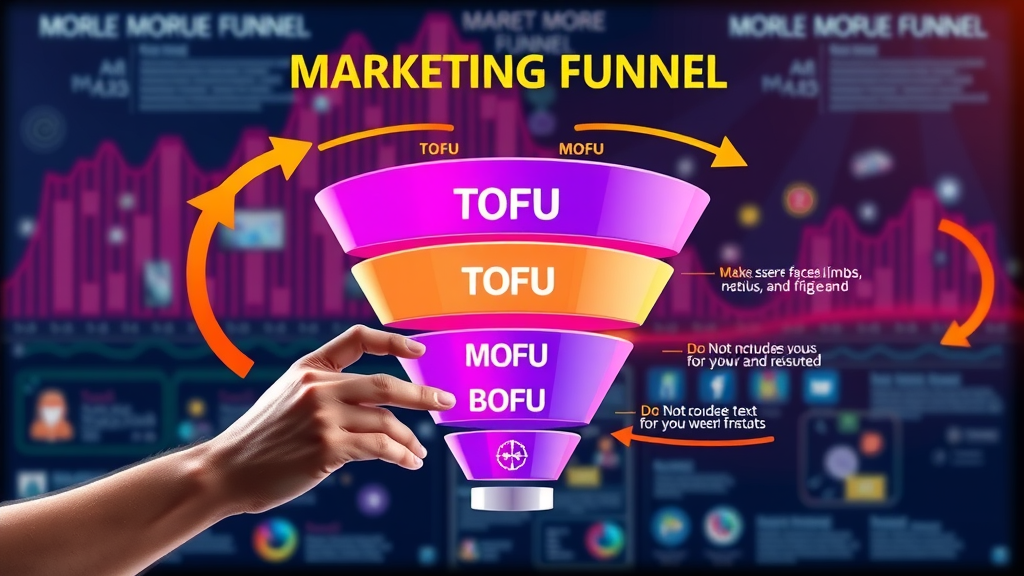
Understanding Digital Marketing Metrics: The Backbone of Results-Driven Success
Did you know that over 73% of successful digital marketing campaigns attribute their ROI gains to effective use of marketing metrics? Harnessing digital marketing metrics can be the differentiator between stagnation and growth.
- Leveraging digital marketing metrics for smarter marketing campaigns
- Distinguishing between essential and vanity marketing metrics
- Interpreting marketing performance indicators to guide data-driven decisions
In today’s fast-moving digital landscape, understanding digital marketing metrics is key to unlocking the true potential of your business’s online presence. Imagine being able to pinpoint exactly which campaigns are working, where your marketing budget delivers the biggest impact, and how every click or interaction moves your business closer to its goals. Digital marketers who embrace metrics-driven strategies consistently outperform their competitors. With a blend of core marketing metrics and insightful key performance indicators, your team can transform raw data into actionable steps for growth.
By making sense of page views, bounce rate, ad spend, cost per click, and return on investment, you gain clarity on where your marketing efforts produce results and where improvements are needed. As we dive deeper into this guide, you’ll discover how to measure, analyze, and optimize your strategies using effective digital marketing metric tracking—setting the stage for your business to thrive in a competitive environment.
Demystifying Digital Marketing Metrics: What Are They and Why Do They Matter?
What Are Digital Marketing Metrics?
Digital marketing metrics are quantifiable measurements used to track, assess, and optimize the performance of all your online marketing activities. These metrics act as the compass for your digital strategy, highlighting both strengths and weaknesses in your campaigns. From tracking the conversion rate of a new landing page to monitoring website traffic spikes after a targeted social media promotion, these indicators provide the groundwork for making data-informed decisions. They allow digital marketers to see which channels are most effective, whether your messaging resonates with potential customers, and where you might be wasting valuable ad spend.
By systematically gathering and analyzing marketing metrics like bounce rate , page views , and cost per click , you can optimize every step of your user’s journey. These data points not only reveal how users interact with your brand but also help you set measurable goals, track progress, and justify future investments in marketing channels that produce results.
The Importance of Marketing Metrics in Achieving Marketing Campaign Objectives
Without a clear set of marketing metrics , measuring the impact of your marketing campaigns is nearly impossible. Metrics provide the crucial feedback loop necessary for all successful marketing teams: they show which campaigns deliver a positive return on investment and which are falling short. By focusing on data-driven outcomes, you ensure every marketing effort aligns with your overall business goals—not just superficial “vanity metrics” like likes or shares.
For example, tracking conversion rates might reveal which content pieces drive users to take the desired action, while analyzing the total number of website traffic helps you understand audience behavior. This iterative approach enables continuous optimization, maximizing every opportunity to attract, convert, and retain customers while effectively managing your budgets and resources.
Table: Common Digital Marketing Metrics & Their Strategic Value

| Metric | What It Measures | Strategic Value |
|---|---|---|
| Conversion Rate | Ratio of users completing a desired action to total visitors | Measures campaign effectiveness and user motivation |
| Bounce Rate | Percent of visitors leaving after viewing one page | Indicates engagement level & landing page relevance |
| Website Traffic | Total number of visits to your site | Shows reach, campaign impact, and awareness |
| Page Views | Total number of times pages are viewed | Helps evaluate content popularity and user interest |
| Customer Acquisition Cost (CAC) | Average cost to acquire a new customer | Measures cost efficiency & profitability |
| Return on Investment (ROI) | Profit generated from marketing vs. spend | Ultimate measure of campaign profitability |
| Ad Spend & Cost per Click (CPC) | Total ad budget and average cost per ad click | Measures paid media efficiency |
| Social Media Engagement | Interactions (likes, comments, shares) | Indicates brand awareness and connection |
Types of Digital Marketing Metrics: Navigating Key Performance Indicators & Performance Metrics
Core Marketing Metrics: Tracking What Matters Most
At the heart of every successful marketing campaign lies a set of core marketing metrics . These are the numbers you monitor closely to ensure your marketing strategy yields real results—metrics such as conversion rate , bounce rate , page views , and ad spend . For instance, a high conversion rate signals that visitors are taking your desired action (like making a purchase or requesting a quote), while a low bounce rate means your content is as engaging as you hoped.
When these metrics are captured consistently, they help marketing teams zero in on what works, what can be improved, and which marketing channels drive the most value. Using digital marketing metrics in this way makes every marketing dollar accountable and ensures your business continuously moves forward.
Key Performance Indicators (KPI) vs. Performance Indicators
Both key performance indicators (KPIs) and performance indicators are essential tools in the digital marketer’s arsenal, but they serve slightly different roles. KPIs are the select metrics that tie directly to your business objectives—think “number of leads,” “sales closed,” or “website engagement duration.” On the other hand, broader performance indicators might measure any aspect of activity, such as page load time or ad impressions, which help round out your analytics but may not directly determine campaign success.
To maximize efficiency, decide from the start which few metrics are your true KPIs, then use other performance indicators to provide context and additional insights. The interplay between these two categories forms the backbone of a metrics-driven marketing strategy .
For a more visual breakdown of these essential terms, watch our explainer video on digital marketing metrics. You’ll see real examples of how to distinguish key performance indicators from general metrics and learn how to choose those that truly represent your digital marketing objectives.
Understanding the nuances between KPIs and supporting metrics empowers marketing teams to prioritize actions that align with strategic goals and drive real growth.
Diving Deeper: Key Metrics Every Digital Marketer Should Monitor
Conversion Rate: The Critical Digital Marketing Metric for Measuring Success

The conversion rate is the gold standard for many digital marketers—it tells you the percentage of visitors who complete a desired action, such as signing up for a newsletter or making a purchase. High conversion rates typically signal effective messaging, targeted audience segments, and smooth user journeys. Monitoring this marketing metric across various campaigns allows you to A/B test landing pages, adjust call-to-actions, and learn which factors truly motivate your audience.
Improving conversion rate is often one of the fastest paths to boosting your marketing ROI. Even small tweaks, informed by clear metrics, can dramatically impact profitability. For any business focused on lead generation or online sales, optimizing conversion rate should be at the core of every digital marketing metric review.
Bounce Rate: Indicator of User Engagement and Website Traffic Quality
Your bounce rate reflects the percentage of visitors who leave your site after viewing only one page. While sometimes overlooked, bounce rate is a key indicator of user engagement and content relevance. A high bounce rate may suggest weak messaging, slow loading pages, or a disconnect between your ads and landing pages, prompting immediate improvements to your user experience or traffic targeting.
Consider analyzing bounce rate alongside website traffic and page views to pinpoint problem areas. Reducing unnecessary bounces helps nurture more qualified leads and keeps potential customers engaged with your brand longer.
Website Traffic & Page Views: Understanding Your Audience's Journey

Both website traffic and page views are fundamental metrics in digital marketing. Website traffic quantifies the total number of visits, showing the reach of your campaigns, while page views offer insight into how deeply users interact with your content. These metrics can help marketing teams understand which pieces of content keep visitors engaged and which channels bring the most valuable traffic.
By tracking the paths that users take through your site—from where they land, what they read, and where they exit—you can identify strengths and weaknesses along their journey. This understanding enables you to create more personalized experiences and targeted offers, with the ultimate goal of increasing overall conversions.
Acquisition Cost & Customer Acquisition: Managing Budgets for Maximum ROI
Acquisition cost —sometimes detailed as customer acquisition cost (CAC) —quantifies how much you need to spend to acquire each new customer. This marketing metric is essential for monitoring the efficiency of your advertising campaigns and ensuring your resources are wisely invested. By comparing CAC to the customer lifetime value , you can gauge long-term profitability and identify where scaling your marketing makes sense.
Analyze acquisition cost by channel—email, social media, paid search, or display—to ensure every dollar spent contributes optimally to business growth. The best digital marketers continually adjust spend based on where CAC yields the highest value and maximum return on investment.
Return on Investment (ROI): The Ultimate Digital Marketing Metric

Return on investment (ROI) is often regarded as the most critical digital marketing metric. It measures the profitability of your digital strategies, reflecting the ratio of net profit to total marketing spend. High ROI means your marketing campaigns are generating significant value relative to their cost, while low ROI highlights areas ripe for improvement or optimization.
Monitoring ROI across marketing channels enables you to shift resources to high-performing platforms and refine campaigns that lag behind. Regular analysis leads to smarter allocation of budgets, more focused effort, and ultimately, more successful marketing outcomes.
Want a step-by-step walkthrough of analyzing your digital marketing metrics ? Watch our in-depth tutorial to learn advanced methods for interpreting marketing analytics dashboards, identifying trends, and drawing out the actionable insights that fuel marketing campaign growth.
Mastering marketing metric analysis transforms your team into a data-driven powerhouse, primed to elevate every campaign’s performance and achieve long-term business goals.
Social Media Marketing Metrics: Measuring and Optimizing Social Impact
Social Media Engagement: The Digital Marketing Metric Behind Brand Awareness

Social media engagement—likes, comments, shares, and mentions—operates at the front lines of your brand’s digital presence. These metrics serve as key indicators of how well your content resonates with audiences and elevates brand awareness. High engagement rates often lead to better organic reach and greater influence, helping marketing teams build loyal online communities.
Optimizing social media engagement begins with monitoring platform-specific metrics, tailoring messages for your target audience, and using A/B testing to discover what formats—image, video, or text—get the most interaction. By regularly reviewing engagement metrics, you improve not only community interaction but also drive click-throughs, conversions, and eventual loyalty.
Ad Spend & Cost per Click (CPC): Maximizing Paid Social Campaign Performance
Managing ad spend and optimizing cost per click (CPC) determine the efficiency of your paid social media campaigns. The lower your CPC, the further your budget will take you. By closely tracking both metrics, digital marketers can experiment with creative variations and audience targeting to minimize waste and increase campaign relevance.
Leverage social platform analytics to monitor the impact of adjustments, increasing the return on every advertising dollar. Carefully attributing ad spend and optimizing CPC ensures that your performance indicators accurately reflect both spending and results.
Choosing the right tools for measuring your social media marketing metrics is crucial. Our video guide compares leading analytics platforms, highlighting features such as real-time tracking, sentiment analysis, and campaign attribution to support superior marketing strategy formulation.
Try integrating these tools into your marketing team’s routine to streamline reporting, reveal deep customer insights, and enable more agile decision making.
Advanced Marketing Metrics: Beyond the Basics
Customer Lifetime Value (CLTV): Projecting Long-Term Relationships

Customer Lifetime Value (CLTV) projects the total revenue you can expect from a single customer relationship over time. Focusing on CLTV moves your marketing from transactional thinking to nurturing high-value clients. By understanding which channels and campaigns attract long-lasting customers, your team can direct resources more efficiently and boost overall profitability.
Regularly comparing CLTV to customer acquisition cost helps identify a healthy balance between spending and expected return, guiding sustainable scaling and reducing churn.
Marketing Funnel Metrics: Identifying Bottlenecks and Opportunities

Marketing funnel metrics allow you to visualize the entire customer journey—from initial contact (Top-of-Funnel) to purchase or retention (Bottom-of-Funnel). Commonly tracked stages include lead generation, nurturing, evaluation, and closing the sale. By reviewing conversion rates at each stage, you can quickly identify bottlenecks, address points of friction, and optimize accordingly.
These insights empower your marketing team to deploy highly targeted campaigns that move potential customers smoothly through the funnel, accelerating time-to-sale and increasing overall campaign ROI.
Segmentation: Using Digital Marketing Metrics for Personalization
Segmentation divides your audience based on behaviors, demographics, or engagement levels by using digital marketing metrics. By segmenting, marketers deliver more personalized content, offers, and experiences—driving up conversion rates and long-term loyalty.
Metrics such as website traffic from different sources, email open rates by segment, or bounce rate across audience types enable granular optimization. Ultimately, segmentation powered by strong marketing metrics ensures every marketing message lands with maximum impact.
Building a Metrics-Driven Marketing Strategy
Choosing the Right Digital Marketing Metrics for Your Objectives

Crafting a successful marketing strategy means starting with clear business goals, then selecting digital marketing metrics that provide direct insight into those objectives. Prioritize metrics that link directly to outcomes, such as leads, revenue, or retention, and avoid focusing on vanity metrics that don’t lead to actionable change.
A thoughtful metric selection process strengthens your performance monitoring and ensures real progress towards market dominance.
Aligning Marketing Metrics with Business Goals and Key Performance Indicators
It’s not enough to just gather data—metrics must align with business goals and focus on true key performance indicators . Whether your goal is brand awareness, lead generation, or maximizing ROI, define KPIs that reflect your strategic direction and use supporting metrics to paint the full performance picture.
Communicate these targets across your marketing team to ensure everyone is driving toward the same outcomes, fostering collaboration and accountability at every stage.
Creating Actionable Dashboards with Marketing Metrics
Dashboards consolidate your key digital marketing metrics in real time, making data actionable and easy to understand. Custom dashboards help monitor everything from website traffic to email engagement, putting timely performance indicators at your fingertips and guiding daily decisions.
The best dashboards are tailored to individual roles in your marketing team, ensuring analytics support strategic workflow and help adapt quickly to changing market trends.
| Tool/Platform | Strength | Best For |
|---|---|---|
| Google Analytics | Comprehensive web and conversion tracking | Site & funnel analysis |
| HubSpot | Integrated marketing automation & CRM | End-to-end campaign management |
| Sprout Social | Social media scheduling & reporting | Social media analytics |
| SEMrush | SEO & competitor benchmarking | Search visibility & keyword analysis |
| Tableau | Customizable analytics dashboards | Advanced data visualization |
Marketing Metrics in Action: Real-World Campaign Examples

Case Study: Improving Conversion Rate with Targeted Metrics Tracking
A SaaS company struggling with a low conversion rate on its free trial signup page used digital marketing metrics to run A/B tests. By tracking user paths, bounce rates, and click-through rates, the marketing team implemented new copy and design elements. The result? Conversion rates jumped by more than 27%, gross revenue increased, and campaign ROI spiked—all tracked and validated via an integrated analytics dashboard.
The success came from focusing on core marketing metrics, quickly identifying weak points, and optimizing based on real-time feedback.
Brand Example: Maximizing ROI Using Integrated Digital Marketing Metrics
An e-commerce retailer seeking to maximize ROI swapped from a channel-based attribution model to a unified dashboard capturing all key performance indicators—from acquisition cost and average order value to social media engagement. Adjusting ad spend in real time ensured budget efficiency, ultimately lowering customer acquisition cost by 18% and boosting ROI by 33%.
This example illustrates how actionable dashboards and a holistic view of marketing metrics can drive impressive results and long-term growth.
"Measurement is the first step that leads to control and eventually to improvement. If you can’t measure something, you can’t understand it." – H. James Harrington
Addressing Common Questions Around Digital Marketing Metrics
What are the metrics used in digital marketing?
Metrics used in digital marketing include conversion rate, bounce rate, website traffic, page views, ad spend, cost per click, social media engagement, customer acquisition cost, and return on investment, among others. Each metric offers insights into specific aspects of campaign performance and helps guide data-driven decisions.
What are the 5 P's of digital marketing?
The 5 P's of digital marketing generally refer to Product, Price, Place, Promotion, and People. Each element should be considered within your digital strategy and measured using relevant digital marketing metrics.
What are KPIs in digital marketing?
KPIs—or Key Performance Indicators—are strategic digital marketing metrics used to measure progress towards a specific marketing objective, such as lead generation, website engagement, or sales growth.
What are the 7 P's of digital marketing?
The 7 P's expand on the original 5 to include Physical Evidence and Process, providing a more comprehensive framework for digital and service-based businesses to measure, manage, and optimize their digital marketing metrics.
Transforming Analytics Into Action: Practical Steps for Implementing Digital Marketing Metrics Insights
- Define business goals clearly and select appropriate digital marketing metrics
- Integrate tracking across all digital marketing channels
- Monitor performance indicators and adjust as needed
- Continuously optimize campaigns using data insights
- Report and communicate findings to all stakeholders
Following these steps empowers your marketing team to unlock the power of digital marketing metrics, building campaigns that aren’t just creative, but also measurable and continually improving.
Expert Tips for Leveraging Digital Marketing Metrics Efficiently
- Analyze your complete marketing funnel using relevant digital marketing metrics
- Avoid " vanity metrics " that don't impact business outcomes
- Schedule regular marketing metric reviews
- Empower your team to make data-driven decisions
These tips ensure your marketing strategy remains agile, accountable, and laser-focused on what matters most—growth.
Frequently Asked Questions on Digital Marketing Metrics
How often should I review my digital marketing metrics?
Ideally, digital marketing metrics should be reviewed at least weekly for active campaigns and monthly for long-term strategy. Regular analysis allows teams to spot trends early, address issues quickly, and make timely adjustments for optimal results.
What tools make the most sense for tracking digital marketing metrics?
Leading tools for tracking digital marketing metrics include Google Analytics, HubSpot, SEMrush, Sprout Social, and Tableau. The best choice depends on your channel mix, budget, and need for customized reporting dashboards.
Can digital marketing metrics predict future campaign performance?
While metrics can't guarantee future outcomes, trend analysis of key performance indicators helps anticipate shifts in engagement, conversions, and customer behavior, allowing marketers to proactively optimize campaigns based on data insights.
Which digital marketing metrics matter most for small businesses?
For small businesses, the most important digital marketing metrics are often conversion rate, acquisition cost, website traffic, social media engagement, and overall ROI. Focusing on these ensures every marketing dollar drives tangible growth.
Get Ahead with Winning Digital Marketing Metrics Strategy
Your next customer is searching online right now—can they find you? Schedule a free strategy session and let’s make your business the one they connect with. Book your free marketing strategy with our team today. Call: 314-560-4642 or visit: https://marketingconnectionsllc.com/get-in-touch
Harness the power of digital marketing metrics, define your KPIs, and commit to ongoing optimization for marketing success.
To deepen your understanding of digital marketing metrics, consider exploring the following resources:
- “15 Digital Marketing Metrics & KPIs to Measure Performance” ( mountain.com )
This article provides a comprehensive overview of essential metrics, including Return on Ad Spend (ROAS) and Cost Per Acquisition (CPA), offering clear explanations and calculation methods to help you assess your marketing campaigns’ effectiveness.
- “Strategic Metrics to Evaluate Digital Marketing Effectiveness” ( dashthis.com )
This resource delves into key performance indicators such as Cost Per Click (CPC) and Return on Investment (ROI), guiding you on how to interpret these metrics to optimize your marketing strategies.
By integrating insights from these authoritative sources, you can enhance your ability to measure and improve your digital marketing efforts effectively.
 Add Row
Add Row  Add
Add 






Write A Comment